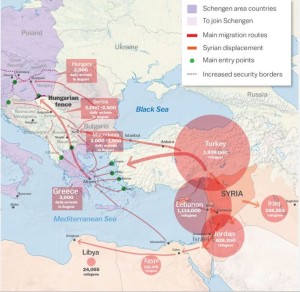Mapping the tragedy of a refugee crisis

The toll…
Syrian Refugees: 4,087,139
People internally displaced within Syria: 7,632,540
People in need of humanitarian help within Syria: 12,200,130
A new map has revealed the scale of the Syrian refugee crisis while pointing out the major land and sea routes and sources of refugees.
The map, produced by the news website Vox World, shows that the largest population of Syrian refugees is not in Europe but in the Middle East, in countries neighbouring Syria.
Many of these are in large and underfunded UN-run refugee camps.
The map helps explain the number of routes into the European Union, and particularly towards northern EU states that are more likely to accept refugees.
Syrian refugees in Turkey or Lebanon frequently go across the eastern Mediterranean to Greece from Turkey, but some also travel to Egypt and take the trans-Mediterranean route there. Some go across land entirely, crossing from Turkey into Bulgaria.
These routes are dangerous. Refugees crossing the Mediterranean often travel in poorly constructed vessels that make even the short trip from Turkey to Greece dangerous.
Around 2,700 people have died so far trying to cross the Mediterranean, including roughly 200 in one desperate late August trip.
Even when they reach land, many refugees are not safe. 71 migrants crammed into a truck suffocated to death in a truck in Austria in August.
Once in European continent, many Syrian refugees go to the Balkans to enter the EU through Hungary or Croatia, the map shows.
But once inside the EU, refugees must confront a number of European countries that are less than welcoming. The border controls between Hungary and its neighbours and between Austria and Germany can effectively be roadblocks for refugees.
Such border controls are also, many argue, against the spirit of the EU, among which the Schengen Area countries (marked in purple) are supposed to allow free movement across one another’s borders.
The map shows that Hungary has built a fence on its border to keep out refugees. Greece, already reeling from its own financial crisis, has been unable to process the thousands of migrants – forcing refugees in places like the island of Lesbos to set up impromptu tent cities near the port.
“Most of the world’s 19 million refugees are not Syrian – about 4 million are from Syria – so the story of the global refugee crisis is far from just a Syrian story,” the website says.
“And many of the stories told in this map, particularly the difficult journeys into and then across Europe, apply to migrants from other countries as well, such as Eritrea, Iraq, Afghanistan, and many others.
“This map focuses on Syrians because the Syrian refugee crisis is itself an important story, and also because it is representative of the broader refugee crisis,” the website says.
Laurie Nowell
AMES Australia Senior Journalist












